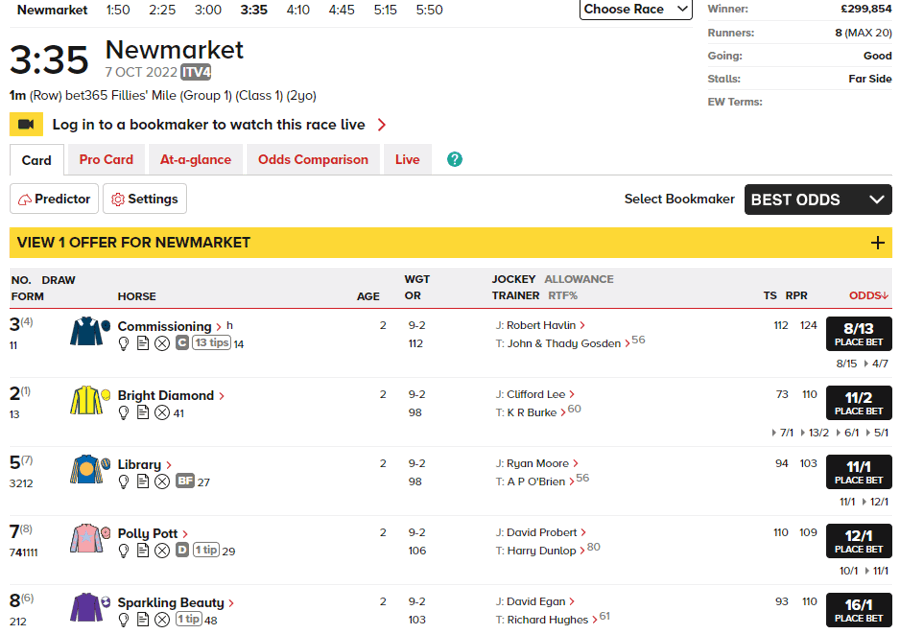
Living in the United Kingdom, it is difficult to deny the love for horse racing. Events take place up and down the country, and people love to go and spectate. It’s a day for many people to dress up and look forward to champagne and cocktails.
They do say that a day at the races is one of the best days out anyone can have. Of course, that all comes down to personal opinion. But, without a doubt, horse racing remains a favourite sport for people to bet on and to do this, it is vital to have access to a race card.
Understanding a race card is also naturally important. After all, what’s the point in using one if you don’t know what anything means on it? Anyone who is not familiar with horse racing betting may find it to be a patchwork of data. But that data is useful for various reasons. Which is why knowing what each of the numbers and phrases mean is important.
While it may be daunting enough to put some people off, it’s simple enough to understand. Once you know it all, you’ll be well on your way and to stop you from veering off course, we have put together a guide to show you how to read a race card.
Jockey Colours
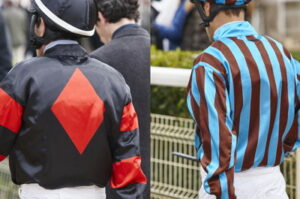 There is a series of colourful jerseys running down the left-hand side of the race card and this is likely to be one of the first features of the card that you notice. It may be self-explanatory to say, but these represent the colour of the jerseys worn by the jockeys.
There is a series of colourful jerseys running down the left-hand side of the race card and this is likely to be one of the first features of the card that you notice. It may be self-explanatory to say, but these represent the colour of the jerseys worn by the jockeys.
There is more to it than that, though. The colours of the jerseys represent the horses’ owners. Jockeys riding on horses owned by a specific stable will always wear that stable’s colours. Two or more horses from a specific stable can compete in the same race. And this is why it is not uncommon to have two jockeys wearing the same colours in one race.
One of the most famous stables was the House of Saud. House of Saud is actually the ruling royal family of Saudi Arabia. Prince Khalid Bin Abdullah was a member of that house. He also owned a breeding farm – Juddmonte. Notable horses from this stable include Frankel, Enable and Dancing Brave. Bin Abdullah often wore a green jersey with a pink sash and cap. He passed away in 2021 at the age of 84.
If two jockeys race for the same owner they wear the same jersey colours but their hat will be different, this is how you can spot them in the race.
Race Number and Draw
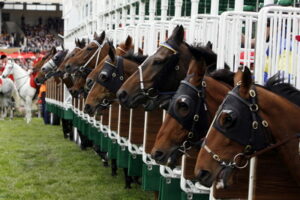 The horses on the race card have a number next to them. Those numbers run from 1 up to the number of horses in the race. Yet under each number, you can also see a number in brackets as well.
The horses on the race card have a number next to them. Those numbers run from 1 up to the number of horses in the race. Yet under each number, you can also see a number in brackets as well.
That secondary number represents the stall that the horse will start the race from. In a flat race, this goes by the name of its draw. As it happens, the draw can be quite the important factor in a race. That is especially true if the race is a shorter one with a larger field of runners. Why? Because there is a bias in place for faster ground on particular sides of the course.
In jump racing horses don’t start in stalls but instead trot up to the start line in unison, therefore the number in jump racing is less important and mostly used to spot your horse when running.
Details at the Top of the Race Card

It is also important to note the details at the top of the race card. It is quite obvious that these represent the race time and the name of the race. But there is a lot more information on it in this location. So, the time of the race and its name are quite simple to understand.
You will also see the prize on offer for the horse that finishes first. It is common to see the group or class that is running in each specific race, too. These range from Grade 1 to Class 6 in National Hunt. In flat races, they range from Group 1 to Class 7. The former number is the best class while the latter is the worst.
At the top of the race card, you may also see details like (3YO+ 0-70), for example. In this instance, you get the information of which types of horses can run in the race. In the example, all horses that have at least three runs receive an official handicap mark.
That ranges from a base of 45 on the flat up to 140. Over jumps, the top rated aren’t usually above 180. In the case of our example above, the race is open to all runners of three-years-old or above. The horses can have an official rating of up to 70. Thus, you get the insight into the types of horses competing.
The final writing at the top of a race card surrounds the length of the race. Let’s say that you’re looking at the race card for the Prince of Wales’s Stakes (Group 1). This has a distance of 1m 1f 212yds written on it. Thus, the race occurs across 1 mile, 1 furlong and 212 yards (or 2,004 metres). You are also aware of how far the horses and jockeys need to travel to complete the race.
Horse Form Numbers
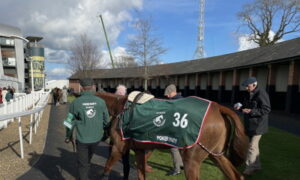 Each horse participating in a race will have form numbers next to its name. These usually come between the jersey colour and the horse on the card. The figures can differ in a big way from runner to runner, too. Let’s use a couple of examples to explain them better.
Each horse participating in a race will have form numbers next to its name. These usually come between the jersey colour and the horse on the card. The figures can differ in a big way from runner to runner, too. Let’s use a couple of examples to explain them better.
The first example comes from the horse called Decorated Knight, whose jockey is in green. It is in position 1 on the race card but will be running from stall number four. The numbers between the jockey and the horse are: 21-1161. The first number in this series is 21. That number refers to where the horse finished in their races last year.
The most recent of those races is always on the right, so in this example, Decorated Knight won that race. If there is a 0 in that number, then it means the horse finished outside of the first 9. The dash symbol in that series stands as a separation between racing seasons. Numbers coming before the dash are for last season. The 1161 thus represents where the horse finished in races this year. Again, the most recent of these is on the right, so the horse won its most recent one in the example.
Example two in horse form numbers is 113/P3-1, which is for the horse Jack Hobbs. There is a slash in this series of numbers. That represents a longer gap, rather than just a gap between two seasons. Jack Hobbs may have missed an entire racing season or two. The ‘P’ that makes up part of the sequence indicates that the jockey pulled the horse up. Thus, the race was not completed.
Other letters that can appear in horse form are:
- F – indicating that the horse fell
- R – indicating that a horse refused
- BD – highlighting that the horse was brought down by another runner
- U – dictating that the horse unseated its jockey
Horse Name and Following Numbers
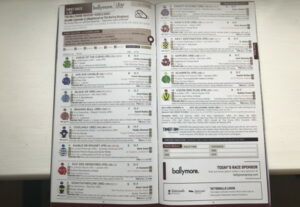 After you see the horse form numbers, the name of each horse is on display. Again, that’s an obvious enough part of the race card.
After you see the horse form numbers, the name of each horse is on display. Again, that’s an obvious enough part of the race card.
The number immediately after its name represents how many days it has been since its last race. It is then not uncommon to see any of the following abbreviations:
- C – this indicates that the horse has won on this particular course before.
- D – denotes that a horse has won over the same distance as this course before.
- CD – indicates that a horse has won both over the same distance an on this course before.
- BF – for ‘Beaten Favourite’, meaning that it was the favourite for its previous race. Yet, in the end, it did not win.
- S – indicates that the horse slipped.
Sometimes, there may be an abbreviation representing the country the horse was born in, too.
Age & Weight
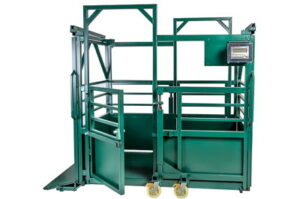
The next number in the selection on there informs you of the age of the horse in question. And after that is its weight in imperial stones and pounds in Great Britain.
Let’s say that you see the following: Queen’s Trust (34) (D) 4 8 11. Queen’s Trust is the horse’s name. It is 34 days since it last competed in a race. It has won over the same distance as this course before. It is four years old, and it is carrying a jockey weighing 8 stone, 11 pounds.
After those numbers comes the jockey’s name. In this example of Queen’s Trust, let’s say that it is being ridden by Oliver Peslier. This displays as O Peslier on the race card. It is also the case that some race cards display each horse’s official BHA Rating.
Once a horse has partaken in enough races, handicappers make a numerical assessment of them. In other instances, a Timeform rating is present. It is also possible for some publications of race cards to have their own rankings.
Using the Queen’s Trust horse again, you may see the number 98 next to O Peslier. This means that it has a rating of 98 out of 100. That puts it up there with any of the same or higher ranking as a potential winner.
Runs, Wins, Places and Prize Money
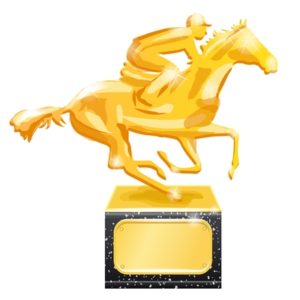 Different race cards can have different designs to them. While some list this information next to its description, others may not. It is quite self-explanatory, though. The runs and wins dictate how many runs the horse has partaken in and how many it has won. The same can be said about the places and prize money won by the horse.
Different race cards can have different designs to them. While some list this information next to its description, others may not. It is quite self-explanatory, though. The runs and wins dictate how many runs the horse has partaken in and how many it has won. The same can be said about the places and prize money won by the horse.
The final piece of information on the race card is the name of the horse’s trainer and its owner. This will always be present on the card. Bettors in particular may know that certain trainers do well with their horses. Or that specific owners have sent various successful horses to races. This gives an insight into potential runners to back.
It’s not only bettors who need to know how to read race cards. So too do tipsters. Many of them will frame their entire strategy around the clock. But it’s also important to note race pace. Some horses perform very well off a fast gallop.
Others run better when there is a steady pace throughout. Generally, those horses tend to have a strong finishing sprint. So, while taking the insights of a race card is good, so too is knowing the horses and riders. This is why thorough research should occur before placing any horse racing bets.
